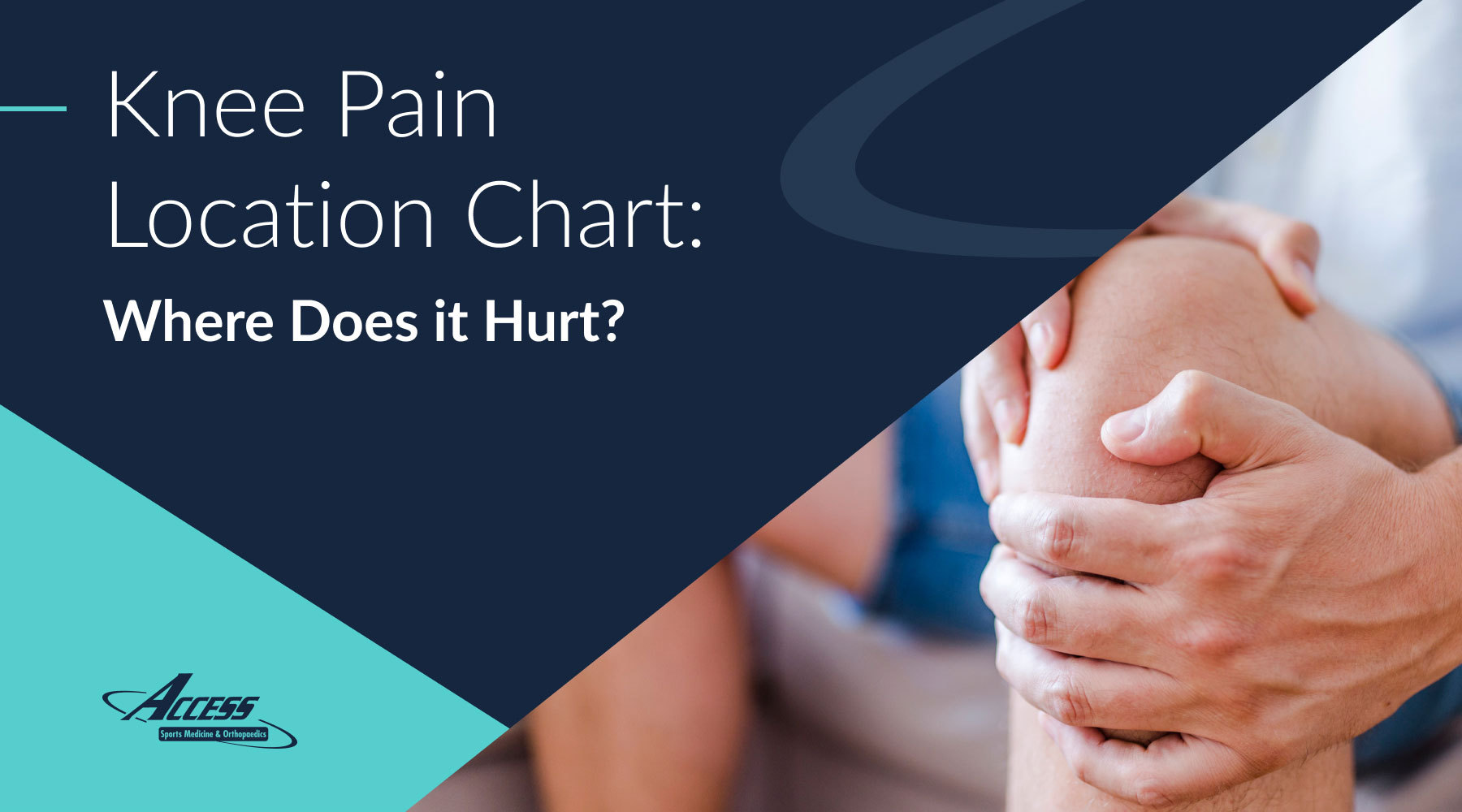
Knee pain is a common problem that can be caused by a variety of factors, including:
- Injury
- Underlying medical conditions
- Normal wear and tear
But how do you know where exactly your knee is hurting? To help with a pre-diagnosis, we’ve created a handy knee pain location chart to pinpoint the exact area of discomfort. Don’t hesitate to reach out and schedule an appointment to ensure you get the proper care to combat prolonged or worsened injury.
Anatomy of the Knee
The knee joint is composed of four bones: the femur (thighbone), tibia (shinbone), fibula (smaller shinbone), and patella (kneecap). These bones are held together by ligaments, tendons, and muscles that support the joint. Pain can occur anywhere within this complex joint, but is typically located in the front, sides, or back of the knee.
The joint also contains fluid-filled sacs called bursae, which help reduce friction between the joint surfaces. The knee is the largest and most complex joint in the human body and can be susceptible to a variety of aches and pains.
Functions of the Knee Joint
In a nutshell, a healthy knee joint enables you to have a wide range of movement and is essential for everyday activities such as walking, running, and jumping. It also provides stability to the body by supporting weight-bearing loads and helping to maintain balance. The ligaments act like strong bands that keep the bones in place and prevent joint dislocation. The tendons and muscles also assist in the movement of the knee joint by acting as shock absorbers. In addition, the fluid-filled sacs help reduce friction between the joints to prevent damage caused by rubbing and grinding.
Causes of Knee Pain
Knee pain can be caused by a wide range of issues, such as overuse, injury, arthritis, and other medical conditions. Overuse injuries can occur when the knee joint is stressed beyond its limits, resulting in inflammation and pain. Injury to any of the components of the joint can also cause pain, including fractures to any of the bones, tears in the ligaments or tendons, or trauma to the cartilage. Arthritis can cause pain when the joint becomes swollen and inflamed due to a breakdown of the cartilage. Some known causes include:
Degenerative conditions
Degenerative conditions that include osteoarthritis, can cause pain in the knee joint due to a breakdown of the cartilage. Osteoarthritis is a chronic condition that results from the wear and tear of aging or overuse. As the cartilage wears away, it exposes the underlying bone which then becomes inflamed and painful.
Traumatic injuries
Traumatic injuries such as an ACL tear can cause pain in the knee joint. An ACL (anterior cruciate ligament) tear occurs when the ligament is stretched beyond its limits, usually due to a sudden twist or overstretching of the leg. Pain and swelling are common symptoms of an ACL tear, and it can often require surgery to repair the damage.
Overuse injuries
Overuse injuries like runner’s knee can cause pain in your knee. Runner’s knee is a common condition caused by repetitive motion and overstressing of the muscles, ligaments, or tendons surrounding the knee joint. Pain, swelling, and tenderness are common symptoms of this type of injury. Treatment typically includes rest, ice, and physical therapy.
Knee Pain Location Chart
Our knee pain location chart, which you can download here for reference, identifies five common areas where knee pain can occur and a pretty comprehensive list of different maladies you might be experiencing. These areas include:
- Front of the Kneecap/Patella – Pain that occurs in the front of the knee is usually due to patellar tendonitis (jumper’s knee) or chondromalacia patella, which is caused by softening of the articular cartilage under the kneecap.
- Inside/Medial Knee – Pain that occurs on the inside of the knee is usually caused by medial collateral ligament (MCL) injury, meniscus tears, or arthritis.
- Outside/Lateral Knee – Pain located on the outside of the knee is often due to iliotibial band syndrome (ITBS), a bursa inflammation, or an MCL sprain.
- Back of the Knee/Popliteal Fossa – Pain located in the back of the knee is usually due to a Baker’s cyst (also known as a popliteal cyst), tendinitis, or arthritis.
- Above the Kneecap/Quadriceps Tendon – Pain located above the knee is usually due to tendonitis in the quadriceps tendon, which connects the kneecap to the thigh muscle.
When to See a Doctor
Knee pain can be caused by any number of factors, many of which should not be ignored and simply treated with over-the-counter remedies. If your knee pain persists, you should schedule an appointment with your doctor’s office, such as the staff here at Access Sports, who specialize in knee injuries and will be able to properly diagnose and treat the source of your knee pain. Depending on the cause, treatment could include physical therapy, medications, injections, or surgery.
To help with pre-diagnosis, our knee pain location chart helps narrow down the source of your discomfort so you and your doctor can converse and take the necessary steps to get you on the road to recovery. This chart is just a tool. It is in no way a substitute for seeing a professional to assess your strain, sprain, or injury fully and aid you in figuring out an applicable cure unique to the discomfort you’re experiencing. Contact Access Sports Med today to schedule your consult.



